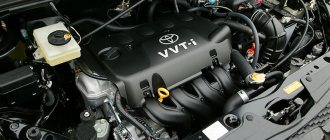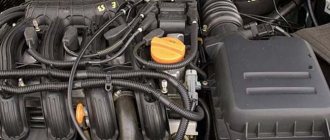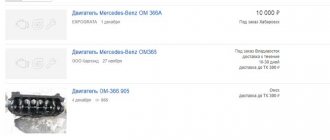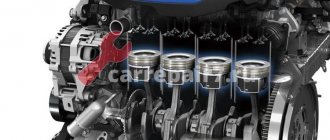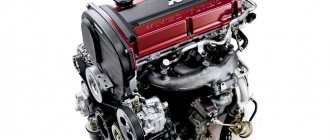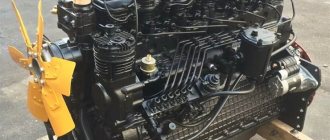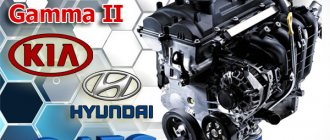Brief introduction
In the 90s, this engine model was considered the “golden mean” of the S series of engines, then produced by the largest Japanese automaker. The engine was not distinguished by its economy, efficiency and high service life, but at the same time it had an advantageous side - maintainability.
The engine was equipped with ten models of cars produced by the Japanese company. The power unit was also used in restyled versions of classes D, D+ and E. Another positive characteristic of the unit is that if the timing belt breaks, the piston does not bend the valve, which was made possible thanks to the counterbore on the surface at the end.
The model is worth noting the presence of MPFI - an electronic multipoint fuel injection system. Factory settings specifically underestimated the engine power for the European market to 120 hp. With. If we talk about torque, it has dropped to 157 Nm.
First, the leading engineers of the manufacturing plant decided to use smaller volumes of combustion chambers in the engine when compared with the previous version of the unit. Instead of 2.0 liters, a volume of 1.8 liters was used. When mentioning the characteristics of the engine, it is worth noting the simplified diagram of an in-line gasoline engine. The installation is equipped with 16 valves, as well as a pair of DOHC camshafts.
The drive of one timing camshaft is belt driven. Attachments are mostly located on the front passenger side. The boost is represented by chip tuning. It is possible to carry out major repairs on your own, as well as modernize the engine to increase power.
Malfunctions and repair of the 4S-Fi/4S-FE engine
The Toyota 4S engine is the youngest in the late S-series line, the other two are 2.0L. 3S and 2.2 l. 5S. The engine replaced the old 1.8 liter 1S and is an absolutely exact copy of the 3S engine, the difference lies in the reduced cylinder diameter (from 86 mm to 82.5 mm), intake and exhaust manifolds. First, in 1987, the 4S-Fi with single-point injection (mono-injection) appeared, and in 1990 it was replaced by the 4S-FE with distributed injection. The advantage of the engine is that if the timing belt breaks, the 4S valve does not bend. However, you shouldn’t tempt fate; replace the belt once every 100 thousand km. Unlike the 3S, no crazy improvement work was done on the engine and there are only three versions of it, more on them below.
Toyota 4S engine modifications
1. 4S-Fi - first version of the engine, mono-injection, compression ratio 9.3, power 105 hp. The engine was produced until 1991. 2. 4S-FE Gen 1 - second version, distributed injection, power increased to 115 hp. The motor was in production from 1989 to 1999 and was installed on the Toyota Corona. 3. 4S-FE Gen 2 - the latest version of the 4S, released in 1995 and produced until 1999. The compression ratio increased to 9.5, power reached 125 hp.
Malfunctions and their causes
The malfunctions of the 4S engine exactly repeat the problems with the 3S, the motors are identical. You can read about the pros and cons of Toyota 3S engines HERE.
To summarize, the Toyota 4S engine is the most ordinary engine of the 90s, quite durable, mileage of 300 thousand or more is not uncommon. The best option for calm movement from point A to point B. In the future, 4S-FE was replaced by the new 1ZZ-FE.
Specifications
| Manufacturer | Kamigo Plant Toyota |
| Weight, kg | 160 |
| Engine brand | 4S FE |
| Years of production | 1990-1999 |
| Power kW (hp) | 92 (125) |
| Volume, cm cube. (l) | 1838 (1,8) |
| Torque, Nm | 162 (at 4,200 rpm) |
| Motor type | In-line petrol |
| Power type | Injector |
| Ignition | DIS-2 |
| Compression ratio | 9,5 |
| Number of cylinders | 4 |
| Location of the first cylinder | TVE |
| Number of valves per cylinder | 4 |
| Camshaft | cast, 2 pcs. |
| Cylinder block material | Cast iron |
| Pistons | Original with countersunks |
| Intake manifold | Duralumin cast |
| An exhaust manifold | Cast iron |
| Cylinder head material | Aluminium alloy |
| Fuel type | Gasoline AI-95 |
| Piston stroke, mm | 86 |
| Fuel consumption, l/km | 5.2 (on the highway), 6.7 (combined cycle), 8.2 (in the city) |
| Environmental standards | Euro 4 |
| water pump | Just Drive JD |
| Oil filter | Sakura C1139, VIC C-110 |
| Compression, bar | From 13 |
| Flywheel | 8 bolt mounting |
| Valve stem seals | Goetze |
| Air filter | SA-161 Shinko, 17801-74020 Toyota |
| Spark plug gap, mm | 1,1 |
| XX speed | 750-800 min-1 |
| Cooling system | Forced, antifreeze |
| Coolant volume, l | 5,9 |
| Adjustment of valves | Nuts, washers over pushers |
| Operating temperature | 95° |
| Engine oil volume, l | 3.3 on Mark II, Cresta, Chaser, 3.9 on all other cars of the brand |
| Oil viscosity | 5W30, 10W40, 10W30 |
| Oil consumption l/1000 km | 0,6-1,0 |
| Tightening force of threaded connections | Spark plug -35 Nm, connecting rods - 25 Nm + 90°, crankshaft pulley - 108 Nm, crankshaft cover - 44 Nm, cylinder head - 2 stages 49 Nm |
The table above shows the fuels and lubricants recommended by the manufacturer.
Tuning
Tuning a Toyota 4S series power unit is quite a complex and time-consuming job.
- It is possible to use a direct-flow exhaust and install an additional spider on the exhaust. This allows you to get about 10 additional horsepower.
- We would not recommend opening the engine and performing deep engineering tuning. Firstly, this work is difficult, and secondly, the car owner does not receive the proper increase in power. The same can be said about installing an additional turbine. Motors of the 4a and 4S series are not designed for a significant increase in power indicators, therefore, when installing even a low-power turbine, its service life indicators are noticeably reduced.
Naturally, from Toyota. A kind of “workhorse”, without any obvious advantages or disadvantages. This engine was produced for quite a long time, from 1987 to 1999, and experienced only one significant change - in 1990 it was replaced by a single multipoint injection, compression and, as a result, power increased slightly. That's all. More than 10 years without significant changes - this is a long time for a Japanese engine. And there is only one explanation for this - the resulting engine was very successful, and a large army of fans confirms this.
So what’s so special about an engine that was neither super-technological, nor super-powerful, nor super-efficient. And the answer is very simple - 4S engine
(first 4S Fi and then 4S FE) was the “golden mean” that made it possible to install one engine on completely different cars, for example on a Celica and a Camry. Moreover, the drivers of these cars, whether a reckless youth or a sedate gentleman, equally felt very confident and reliable.
So what are the pros of this engine? With its small volume (1838 cm3), already in 1987 it had four valves per cylinder, power 105/125 hp. s., and more than 150 Nm of torque. At the same time, it had a belt drive, which had a beneficial effect on noise; in the event of a breakdown, the valves did not bend (another plus for maintainability), and the service life of the motor itself was close to a million kilometers.
Now we are very close to the renovation. Despite being the "little brother" of the larger and therefore more powerful 3S engine, the 4S engine was not a poor cousin. Being a successful creation of the Toyota company, motorists all over the world rightfully recognized its “indestructibility” and learned to “treat” its “sores.” Although he didn’t have any “sores”, all the troubles were caused by excessive use and poor quality maintenance.
Although the 4S engine still has at least two disadvantages. The first is increased noise. Although some will say that this is in the category of nit-picking, while others will note that high-quality sound insulation will significantly improve the situation. And secondly, such high-quality, and most importantly, simple engines are no longer produced. They could still be serviced “in the garage, on the knee,” rather than connecting a powerful computer in order to detect ordinary carbon deposits on spark plugs.
Tuning. And here everything is simple - the more popular the device, and in this case the engine, the wider the choice of tuning kits - from simple “brain re-flashing” to deep tuning, where sometimes all that remains of the engine is the cylinder block, and even that is sharpened.
Otherwise, it’s a very good choice. And the choice, as you know, remains yours.
In the original modification, the 4S engine had the 4S-Fi index and was equipped with mono injection. Produced from 1987 to 1990 as a replacement for 1S-Ui. Since 1990, the engine received the 4S-FE index, distributed multipoint fuel injection, slightly more power and compression ratio. It was produced in this form until 1999.
Specifications
| Production | Kamigo Plant |
| Engine make | Toyota 4S |
| Years of manufacture | 1987-1999 |
| Cylinder block material | cast iron |
| Supply system | carburetor/injector |
| Type | in-line |
| Number of cylinders | 4 |
| Valves per cylinder | 4 |
| Piston stroke, mm | 86 |
| Cylinder diameter, mm | 82.5 |
| Compression ratio | 9.3 9.5 |
| Engine capacity, cc | 1838 |
| Engine power, hp/rpm | 105/5600 115/5600 125/6000 |
| Torque, Nm/rpm | 149/2800 157/4400 162/4600 |
| Fuel | 95 |
| Environmental standards | — |
| Engine weight, kg | — |
| Fuel consumption, l/100 km - city - highway - mixed. | 8.2 5.2 6.7 |
| Oil consumption, g/1000 km | up to 1000 |
| Engine oil | 5W-30 / 10W-30 |
| How much oil is in the engine, l | 4.2 |
| Oil change carried out, km | 10000 (better 5000) |
| Engine operating temperature, degrees. | 95 |
| Engine life, thousand km - according to the plant - in practice | — 300+ |
Common faults and operation
- The injection pump has become unusable. The breakdown is accompanied by gasoline leaking into the crankcase and the breakdown of the ShPG. The main signs are an increase in oil with a characteristic gasoline smell, jerking while driving, uneven operation, frequent stopping, and the speed fluctuates. You just need to replace the injection pump.
- Sticking of the EGR valve system - exhaust gas recirculation. The reason is the formation of tar due to poor fuel. Symptoms are interruptions in speed, disruptions in the rhythm of the unit. The valve must be periodically cleaned or turned off.
- The revs drop and the engine stalls. Problems with idle speed can be treated by flushing the throttle valve module. The intake manifold also needs to be cleaned. It is possible that the air filter or fuel pump is broken.
- Burnt gasoline (sometimes severe). It is necessary to adjust the ignition, clean the injectors, idle valve and BDZ.
- Vibration. Problems are caused by loosening of the aggregate cushion or stopping of one of the cylinders.
- Motor overheating. The radiator cap is to blame and should be replaced.
With proper care, the 4S is a fully functional and even playful unit. The resource easily exceeds 300 thousand km.
4S Engine Video
Since 1987, Toyota cars have been equipped with the 4s fe engine. This is an atmospheric power unit with good technical characteristics. The motor was installed on various car models.
Design features of the motor
The engine of the model in question is ready to boast a number of features that you should be familiar with. Here are the main features of the motor:
- Availability of MPFi system for single-point injection
- The cooling jacket is made inside the block during its casting
- 4 cylinders are machined into the cast iron body of the block, while the surface is hardened by honing
- The distribution of the fuel mixture is carried out by two camshafts according to the DOHC scheme
- It is recommended to use motor oil with viscosity 5W30 and 10W30
- Availability of fuel injection pump to increase the compression ratio
- Availability of MPFi system for multi-point injection
- DIS-2 ignition system without spark distribution
The key features don't end there. You can find out more on thematic forums.
Advantages and disadvantages
Like any technical device, the 4S-FE engine has advantages and disadvantages. It’s worth starting with the advantages of the motor:
- There are no complex mechanisms
- Impressive operational potential reaching 300 thousand kilometers
- Pistons do not bend valves when timing belt breaks
- Excellent maintainability with three oversize piston sizes and cylinder bore capabilities
There is some tar in the ointment, so it’s also worth getting to know the shortcomings. Frequent adjustment of valve thermal clearances is a definite disadvantage of the motor of this model. This is caused by the lack of phase control systems. The original solution of the company's developers simplifies the design on the one hand, since a pair of coils supplies a spark to 2 cylinders; there is an idle spark in the exhaust phase on the other side. It is also worth noting the increasing load on the spark plugs, due to which the service life is reduced. Specialists of the Japanese brand used a high-pressure pump in the engine, which often causes floating speeds and an increase in the oil level, and this is undoubtedly a minus.
What cars is the engine installed on?
As mentioned above, the engine of this model was installed on a number of Japanese cars. We present to your attention a complete list of Toyota car models, at one time equipped with a motor:
- Chaser mid-size sedan
- Cresta business class sedan
- Five-door station wagon Caldina
- Vista compact sedan
- Four-door Camry business class sedan
- Mid-size station wagon Corona
- Mark II midsize sedan
- Celica sports hatchback, convertible and roadster
- Curren two-door coupe
- Left-hand drive export sedan Carina Exiv
4S-FE under the hood of Toyota Vista Based on what was written above, the engine is widely popular due to its characteristics.
List of car models in which it was installed
The 4S FE engine was used exclusively for Toyota cars of the following models:
- Cresta – business class, sedan;
- Chaser – mid-size sedan;
- Mark II – mid-size sedan;
- Vista – compact sedan, frameless doors, for the domestic market only;
- Celica – sports hatchback, convertible and roadster;
- Caldina – five-door station wagon;
- Carina – middle class, sedan;
- Carina Exiv – left-hand drive export sedan;
- Camry – business class, four-door sedan;
- Corona – mid-size station wagon;
- Curren is a two-door coupe.
Toyota Caldina
On cars produced up to and including 1992, the inscription 16 VALVE EFI was applied to the rear window.
Regulatory requirements for engine maintenance
There are manufacturer-defined requirements and recommendations for servicing the power unit:
- The Gates timing belt has a service life of 150,000 miles.
- The oil filter must be replaced along with the lubricant. The air filter is changed every year, while the fuel filter must be replaced after 40,000 kilometers (about once every 3 years)
- Working fluids lose their properties after 10–40 thousand kilometers. After exceeding the mark, it is necessary to change the engine oil and antifreeze
- Thermal valve clearances must be adjusted once every 20 - 30 thousand kilometers.
- The spark plugs in the system are used for 20,000 kilometers.
- Crankcase ventilation is purged every 2 years
- The battery life is determined by the manufacturer, as well as the operating conditions of the vehicle.
By adhering to the manufacturer's instructions, it is possible to operate the engine for as long as possible.
Key malfunctions: causes and solutions
| Type of failure | Cause | Remedy |
| The engine stalls or runs unstably | EGR valve failure | Replacing the Exhaust Recirculation Valve |
| Floating speed while simultaneously increasing the oil level | Fuel injection pump malfunction | Repair or replacement of the high pressure fuel pump |
| Increased gasoline consumption | Clogged injectors/IAC failure/misadjustment of valve clearances | Replacing injectors/replacing the idle air control/adjusting thermal clearances |
| XX RPM problems | Throttle valve clogged/fuel filter life expired/fuel pump failure | Purge the damper/replace the filter/replace or repair the pump |
| Vibrations | Wear of engine cushions/rings stuck in one cylinder | Replacement of pillows/major repairs |
Weak motor
Toyota engines produced in the A series are the most common and are quite reliable and popular. 4A in all its modifications occupies a worthy place At the very beginning the engine had low power. It was manufactured with a carburetor and one camshaft, the engine head had eight valves.
During the modernization process, it was manufactured first with a 16-valve head, then with a 20-valve head and two camshafts and with electronic fuel injection. In addition, the engine had a different piston.
Some modifications were assembled with a mechanical supercharger. Let's take a closer look at the 4A motor with its modifications and identify its weaknesses and shortcomings.
motor modifications :
Toyota cars were produced with the 4A engine and its modifications :
In addition to Toyota, engines were installed on cars:
Weaknesses of the 4A engine
Weaknesses of the engine in more detail...
Failure of a lambda probe or, in other words, an oxygen sensor does not happen often, but in practice it does occur. Ideally, for a new engine, the service life of the oxygen sensor is small, 40 - 80 thousand km; if the engine has a problem with the piston and with fuel and oil consumption, then the service life is significantly reduced.
Absolute pressure sensor
As a rule, the sensor fails due to a poor connection between the inlet fitting and the intake manifold.
Engine temperature sensor
It does not refuse often, as they say rarely but aptly.
The problem with crankshaft seals is related to the elapsed life of the engine and the elapsed time from the moment of manufacture. It manifests itself simply as a leak or squeezing out of oil. Even if the car has low mileage, the rubber from which the seals are made loses its physical properties after 10 years.
Disadvantages of the 4A engine
Disadvantages of the 4A motor in detail...
Increased fuel consumption
The reason for increased fuel consumption may be:
Engine idle speed fluctuates or increases
The cause may be a malfunction of the idle air valve and carbon deposits on the throttle valve, or a malfunction of the throttle position sensor.
Just in case, clean the throttle valve, wash the idle air valve, check the spark plugs - the presence of carbon deposits also contributes to the problem with engine idle speed.
It would not be superfluous to check the injectors and the operation of the crankcase ventilation valve.
The engine does not start, stalls with floating speed
This problem indicates a malfunction of the engine temperature sensor.
In this case, this may be due to a clogged fuel filter. In addition to searching for the cause of the malfunction, check the operation of the fuel pump and the condition of the distributor.
Increased oil consumption
The manufacturer allows normal oil consumption of up to 1 liter per 1000 km; if it is more, it means there is a problem with the piston. Alternatively, replacing the piston rings and oil seals may help.
Engine knocking is a signal of wear on the piston pins and a violation of the timing valve clearance in the engine head. In accordance with the operating manual, the valves are adjusted after 100,000 km.
Cars with Lean Burn version engines will be very expensive; they run on a lean mixture and as a result their power is much lower, they are more capricious, and consumables are expensive.
All the described weaknesses and shortcomings are also relevant for engines 5A and 7A.
Engine tuning
If we are talking about a naturally aspirated engine of this model, which is intended for import into Europe, then it has underrated characteristics. That is why, in order to restore the factory power of 125 hp. With. and torque at around 162 Nm, engine tuning is carried out. Mechanical tuning will cost much more, but will allow you to get 200 hp. With. To do this, you need to purchase an intercooler for air cooling, install a direct-flow exhaust and a “spider” instead of the standard exhaust manifold. You will also need to grind the intake tract channels and use a zero resistance filter. Be that as it may, in any case, tuning will cost a large sum, which is extremely undesirable for the owner.
Toyota 4S-FE engine tuning
Chip tuning. Atmo. Turbine
Modifying the 4S engine is a terribly difficult and illogical task, but something needs to be done, so we install a cold air intake, a 4-2-1 spider exhaust and a full direct-flow exhaust, Apexi S-AFC II and we will get up to 10 hp. There is absolutely no point in climbing further because the car will not get off the lift. Regarding the turbine, the issue of supercharging periodically prevents the owner of a 4S engine from falling asleep, but let's think sensibly, the 4S-FE will not withstand the pressure and the entire bottom will need to be replaced, instead light forging is installed for a low coolant, the head will require porting, installation of lightweight enlarged valves, replacement camshafts, to put it simply, only the cylinder block will remain factory. To this we add a turbo kit, injectors, exhaust and tuning. The most correct tuning of the 4S-FE is to replace it with the initially fast and reliable 3S-GTE.
202

